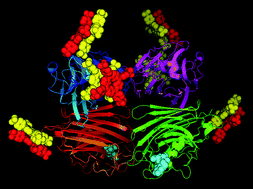Although for a long time carbohydrate binding property has been used as the defining feature of lectins, studies carried out mostly during the last two decades or so demonstrate that many plant lectins exhibit specific interactions with small molecules that are predominantly hydrophobic in nature. Such interactions, in most cases, appear to be at specific sites that do not interfere with the ability of the lectins to recognise and bind carbohydrates. Further, several of these ligands have binding affinities comparable to those for the binding of specific carbohydrates to the lectins. Given the ability of lectins to specifically recognise the glycocode (carbohydrate code) on different cell surfaces and distinguish between diseased and normal tissues, these additional sites may be viewed as potential drug carrying sites that could be exploited for targeted delivery to sites of choice. Porphyrin–lectin complexes are especially suited for such targeting since porphyrins are already under investigation in photodynamic therapy for cancer. This review will provide an update on the interactions of plant lectins with non-carbohydrate ligands, with particular emphasis on porphyrin ligands. The implications and potential applications of such studies will also be discussed.

You have access to this article
 Please wait while we load your content...
Something went wrong. Try again?
Please wait while we load your content...
Something went wrong. Try again?


 Please wait while we load your content...
Please wait while we load your content...